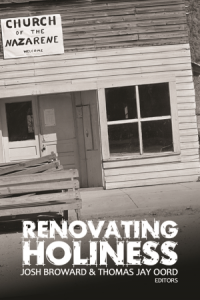3 Themes Young Holiness Leaders Care About
I’m happy to announce that a new book I have co-edited with Josh Broward is now available. Renovating Holiness brings together 120+ Millennial and Xer leaders in the Church of the Nazarene to explore holiness afresh.
The book that results is nearly 500 pages long! We wanted to include as many voices as possible. And we wanted strong representation from Church of the Nazarene leaders outside the U.S. 
My own essay offers some summary comments meant to identify key themes that emerge in the essays. I identify ten such themes, but I focus below on just three. Some of the essays in Renovating Holiness emphasize that…
There’s still a credibility gap.
Even in John Wesley’s day, many struggled with the discrepancy between how some Christians claimed holy living should look and the actual way holiness people lived. Some theories of sanctification did not match the actual practice of sanctification.
Mildred Bangs Wynkoop described this discrepancy as a “credibility gap.” Many holiness folk claimed to have lost their sin nature, for instance, but the way these folk lived their lives suggested they were still engaged in sin. Others claimed sinless perfection but failed to explain convincingly what Christian perfection involved.
In this book, Xer and Millennial essayists emphasize the importance of lived experience. Holiness must be practical, applicable, and possible. It may also be difficult, and it may mean acting in counter-cultural ways. Christ-like transformation requires breaking ingrained propensities toward sin and developing habits of life-giving love. In sum, Millennials and Xers seem to seek a realistic rather than utopic Christian life.
Being holy means engaging culture.
From its inception, those in the holiness tradition have cared about social issues. Many essayists in this book carry on this concern, some even addressing the same issues holiness leaders of yesteryear addressed. The sanctified life has a strong public component.
For instance, some writers renew the denomination’s early push for women to serve in leadership roles. Others call for greater personal discipline or abstinence. Essayists express the importance of caring for the poor. Xers and Millennials care about helping people break addictions and live healthy lives.
We also find Xers and Millennials in this book addressing social issues rarely addressed in the early holiness tradition. For instance, some speak out against nationalism, arguing that allegiance to Christ comes before allegiance to nation. Others say being holy means being environmentally responsible. I also find young holiness leaders engaging the issues of homosexuality to a greater extent, greater depth, and with different views than leaders of yesteryear.
I’m struck by the general approach many Xers and Millennials have toward popular culture. While not accepting it uncritically, they view it more favorably than holiness leaders in the early and mid-20th century. Many engage popular culture without simply castigating it, actually believing they can learn something positive from the world in which they live.
Hospitality is the way of holiness.
The final theme I find often in these essays is identified by a few as “hospitality.” Many essayists preach the importance of openness, care, and charity toward those who think differently than the essayists themselves. They welcome the stranger, both in the literal and ideological senses of “stranger.”
I see a connection between hospitality as a key form of holiness and the first theme I mentioned above: diversity. Millennials and Xers in various cultures of the world seem more aware of differences. These differences may be social, linguistic, ethnic, ideological, religious, or something else. We live in a multi-faceted world.
In this context, essayists appeal to love as the way to engage well those who are different, in whatever way, from themselves. Many seek shalom. And promoting the love of shalom means being hospitable.
Conclusion
There are many other dominant themes in the book. And I plan to explore some of those themes in future blogs.
I’d love to hear your thoughts on these. One main reason Josh and I put together Renovating Holiness was to spark conversations to deepen, widen, and perhaps incorporate both old and new issues.
We believe we must think anew about how to respond to the timeless call to be holy as God is holy.

Comments
the book Renovating Holiness is a breath of fresh air!